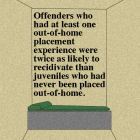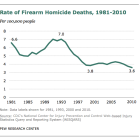
Past Traumatic Experiences Common Among Detained Juveniles
|
Most young people placed in detention have experienced at least one traumatic event in their lifetime, according to a new report from the OJJDP.
Juvenile Justice Information Exchange (https://jjie.org/author/james-swift/page/7/)

Most young people placed in detention have experienced at least one traumatic event in their lifetime, according to a new report from the OJJDP.

A report released by the American Civil Liberties Union (ACLU) earlier this week found that in 2010, African-Americans were approximately four times more likely than whites to be arrested for marijuana possession -- this, despite that fact that national data indicates the two populations use marijuana at nearly the same rates. Furthermore, in several states, including Illinois, Iowa and Minnesota, the ACLU said African-Americans were busted for pot at rates from 7.5 to 8 times higher than whites. Regardless of region, the ACLU reports that these discrepancies in arrest rate by race remain consistent. “In over 96 percent of counties with more than 30,000 people in which at least 2 percent of the residents are black,” the report reads, “blacks are arrested at higher rates than whites for marijuana possession.”
Overall, New York, Texas, California, Florida and Illinois were found to have the highest rates of marijuana possession arrests. In almost half of all states, the ACLU found that possession offenses accounted for more than 90 percent of marijuana arrests.

The Supreme Court of Mass. shoots down a petitioner’s claim that a state law forbidding the issuance of firearm permits to individuals with juvenile felony records was unconstitutional.

Nebraska’s juvenile justice system will have a new focus on rehabilitation thanks to a bill signed into law Wednesday by Gov. Dave Heineman. Legislative Bill 561 (LB561), introduced by state Sen. Brad Ashford (I-Omaha), will allocate $14.5 million towards several new services, as well as a grant program to aid counties in treating juvenile offenders. The bill decreases the state’s dependency on juvenile detention programming, placing a greater emphasis on youth rehabilitation. The new measure also transfers juvenile offender supervision over to Nebraska’s Office of Probation Administration, which is subordinate to the state’s Supreme Court. Prior to the legislation taking effect, Nebraska’s juvenile populations were instead overseen by the state’s Department of Health and Human Services.

An OJJDP-sponsored webinar last week discussed the merits of youth courts as an alternative school disciplinary approach.

On Thursday, Coalition for Juvenile Justice (CJJ) Executive Director Nancy Gannon Hornberger announced that she will be resigning from the position this August. Hornberger has been a member of the CJJ for nearly a decade and a half. Prior to serving as the organization’s executive director, Hornberger also served as CJJ’s deputy executive director. Her career in youth development, delinquency prevention and public policy stretches back a quarter century, having received commendation for her efforts from President Bill Clinton in 1996. As an advocate, she fought a four year battle for the reauthorization of the Juvenile Justice and Delinquency Prevention Act (JJDPA), which was ultimately authorized by Congress in 2002.

A new report issued by the Pennsylvania Juvenile Court Judges’ Commission finds that among juveniles whose cases were closed in 2007, one-in-five recidivated within two years. The Pennsylvania Juvenile Justice Recidivism Report found juvenile recidivism rates to be as high as 45 percent in some counties, with the average length between case closure and recidivism to be 11.5 months. The younger a juvenile at the time of one’s first written allegation, the study found, the likelier the juvenile was to recidivate. Conversely, the report found that juveniles who were older at the time of case closures were more likely to recidivate than those whose cases were closed at an earlier age. Additionally, juveniles with more formal dispositions on their cases -- such as placement or probation -- were found to recidivate at higher rates than offenders who were given less formal dispositions, such as counseling.

Pew Research Center released a report tracking the trajectory of firearm-related homicides over the last 20 years, finding that the overall rate of murders committed with guns has declined, finding that the overall rate of murders committed with guns has declined from a national rate of 7 deaths per 100,000 in 1993 to just 3.6 deaths per 100,000 in 2010. The drop-off constitutes a 49 percent decrease in gun-related crime deaths, with current gun homicide rates in the United States at their lowest levels since the early 1960s.

The initial results from a study analyzing youth violence in a small Denver neighborhood finds that the roots of adolescent delinquency may be found in tumultuous, early home-life experiences.

A new edition of the psychiatric "bible" will be released May 17, arriving on a wave of controversy that may have a profound influence on children’s mental health care in the United States.